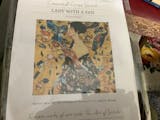Emily Carr (3)
Emily Carr (1871–1945) was the Canadian artist who took one look at the forests of British Columbia and said, “This deserves a paintbrush, not just a postcard.” Known for her bold, expressive landscapes and depictions of Indigenous culture, Carr didn’t just paint scenes—she captured the soul of the Pacific Northwest with enough energy to make you feel the wind through the trees.
Carr’s love affair with nature wasn’t just casual—it was deep and intense. Her towering forests, swirling skies, and vibrant greens make you think, “Is it possible to hug a painting?” She approached her subjects with reverence, often painting from unusual perspectives that made the natural world feel alive and almost spiritual. Her trees don’t just stand—they breathe, twist, and reach, as if they have their own personalities.
But Carr wasn’t all about landscapes. She also spent much of her career documenting Indigenous art and culture, including totem poles, villages, and ceremonial masks. While she was fascinated by these traditions, it’s important to acknowledge the complexities of her position as a settler artist during a time when Indigenous cultures were being marginalized. Her work played a role in raising awareness of these artistic traditions, but it’s a legacy viewed today through a critical lens of cultural respect and representation.
Carr didn’t have an easy road to success. For much of her life, she was underappreciated and struggled to make ends meet. At one point, she even ran a boarding house, which—let’s be honest—probably didn’t leave much room for painting. But in her later years, she gained recognition for her unique style and became a key figure in Canadian modernism, hanging out with the Group of Seven and proving that her art was as strong as the trees she painted.
In a world of polite Canadian landscapes, Carr was the artist who turned up the drama. Her works remind us that nature isn’t just scenery—it’s alive, powerful, and worth celebrating. So next time you’re in the woods, take a deep breath and thank Emily Carr for reminding us to look up at the trees.












